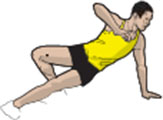DO THESE DRILLS TO STAY HEALTHY
When runners get together you can be certain two topics of conversation will arise. The first is their personal bests, the second the various injuries they’ve suffered chasing those times. Indeed, a Danish study found that out of 930 new runners – those who had only started in the last year – 254 suffered a running-related injury within 12 months of training.
“Bad movement patterns and muscular imbalances can cause damage to ankles, knees and hips and contribute to injury, which is why all my running clients lift, jump and squat,” says coach and sports science expert David Arnot, cofounder of personal training studio Evolve 353. Try Arnot’s at-home drills to injury-proof your body. “The aim with these sessions isn’t to increase the size of your muscles but their strength and stability so you run more efficiently and reduce your risk of injury,” he says.
❶ LYING HIP CLAM
Why This move strengthens your glutes and will prevent your knees caving in during your runs to reduce the chances of developing long-term knee injuries.
How Lie on your side with your knees slightly bent and one leg resting on top of the other. Raise your top knee as high as you can, pause, then lower back to the start. Complete all the reps on one side, then switch and do it on the other side.
How many Do three sets of 15-20 reps with 60 seconds’ rest between sets.
❷ UNWEIGHTED SQUAT
Why Squats increase leg strength so that each stride will become easier. To make this move harder, you can do it while holding a dumbbell in each hand by your sides.
How Stand tall, keeping your chest up. Bend your hips and knees to squat down as deep as you can, until your thighs are at least parallel to the floor. Keep your knees in line with your toes, and your weight on your heels.
How many Do three sets of 12-15 reps with two minutes’ rest between sets.
❸MULTI PLANE LUNGE
Why These will give you strength in different positions – you want to be strong as you turn, not just on the straights. You can also do this move holding a pair of dumbbells by your sides in each hand.
How Stand tall, keeping your chest up, then lunge forward and back, then to the side and back, then behind you and back, with good form. Do all the reps, then swap legs and repeat.
How many Do three sets of 15 reps on each leg, with two minutes’ rest between sets.
❹ BOX JUMP
Why Doing this move improves power through the hips and will help your leg drive up those hills. Make sure you have a solid raised box or platform to use.
How Stand in front of a knee-height box. Drop into a quarter-squat, swing your arms back then explode upwards to jump onto the box. Bend your knees as you land to absorb the force, step down and repeat. Stop if you feel fatigued.
How many Do three sets of eight reps with two minutes’ rest between sets.






